Start » Bottom fertilizer: key strategy for growing pistachio trees.
Bottom fertilizer: key strategy for growing pistachio trees.
Table of Contents
Estimated reading time: 12 minutes
The bottom fertilizer is essential for the optimal development of the pistachio tree. It provides key benefits to the crop, such as ensuring nutrient availability from the start and promoting a balance in the root system. A prior analysis of the land is essential to determine the fertilization plan, considering factors such as the necessary nutrients and adjusting the dosage according to the needs of the pistachio tree. The appropriate application and timing, as well as the combination with fertigation, are also aspects to take into account. The subsequent care of the fertilizer and irrigation management are important for the success of the crop. #Abackground #Pistacher
Importance of the background fertilizer in the development of the pistachio tree
The bottom fertilizer plays a crucial role in the healthy and productive development of the pistachio tree. By providing the necessary nutrients from the beginning of the plant's annual life cycle, this technique contributes to vigorous and balanced growth.
Benefits of bottom fertilizer for pistachio cultivation
The bottom fertilizer offers a series of benefits that are essential for the successful cultivation of the pistachio tree:
- Early nutrient availability: By applying top dressing in the winter, you ensure that nutrients are available to the plant from the beginning of spring.
- Stimulation of root development: Bottom fertilization favors the growth and development of the root system, which provides a solid base for the pistachio tree and allows it to absorb nutrients more efficiently.
- Improved fruit quality: Proper bottom fertilization guarantees the supply of essential nutrients, which is reflected in the quality and flavor of the fruits produced.
- Increased resistance to diseases: By properly nourishing the pistachio tree, its immune system is strengthened, making it more resistant to diseases and pests.
- Improves soil quality and texture: The activated organic matter increases its fertility and multiplies the diversity of microbiological species in our crop plot, improving the physical, chemical and biological properties of the soil, increasing its humidity by better retaining water from irrigation or rain. It is recommended in poor, punished or blocked soils, and with unbalanced pH.
In summary
The bottom fertilizer plays a fundamental role in the cultivation of the pistachio tree,ensuring an early supply of nutrients and balanced root development. Its benefits go beyond growth and productivity, influencing fruit quality and disease resistance. Proper planning is essential, taking into account the specific needs of the pistachio tree and the composition of the fertilizers used, to obtain the best results in the crop.
Previous analysis of the land to determine the fertilization plan
The previous analysis of the terrain It is a fundamental stage to establish an adequate fertilization plan for the cultivation of pistachio trees.. Through this analysis, valuable information is obtained about the characteristics of the soil, its composition and properties, which will allow the nutritional needs of the crop to be determined.

Factors to consider in the analysis of the terrain
- Soil texture: The type of soil, whether sandy, loam, clay or mixed, influences the capacity to retain water and nutrients. It is important to know this characteristic to adjust the dosage of fertilizers.
- Soil pH: pH is another relevant factor, since it determines the availability of nutrients for plants. An adequate pH guarantees optimal absorption of nutrients by the pistachio tree.
- Nutrient retention capacity: Each soil has a certain capacity to retain the nutrients necessary for cultivation. It is essential to evaluate this capacity and adapt the subscriber plan accordingly.
- Presence of toxic elements: The analysis of the soil also allows us to detect the presence of toxic or polluting elements that may affect the development of the pistachio tree. If they are found, the necessary measures must be taken to correct this situation.
The role of nutrients: phosphorus, potassium and nitrogen
The essential nutrients for the pistachio tree are phosphorus, potassium and nitrogen, which play a crucial role in their development and productivity.
- Match: This nutrient is essential in the formation of roots and in the flowering and fruiting process of the pistachio tree. A phosphorus deficiency can limit its growth and affect the quality of the fruits.
- Potassium: Potassium contributes to the water balance of the plant, improving its resistance to stress conditions and promoting greater quality in the pistachio kernel. In addition, it favors the transfer and accumulation of other nutrients.
- Nitrogen: Nitrogen is essential for the vegetative growth of the pistachio tree, stimulating the production of leaves and branches. However, excess nitrogen can be harmful, reducing disease resistance and affecting fruit quality.
The analysis of the terrain allows us to evaluate the availability of these nutrients in the soil and determine the appropriate quantities to apply during bottom fertilization, ensuring an optimal supply for the pistachio tree at each stage of its development.
Choice and dosage of fertilizers for bottom fertilization
The background subscriber It is a crucial stage in the cultivation of the pistachio tree, and to obtain good results it is essential to choose the appropriate fertilizers and adjust their dosage according to the needs of the tree. Below are the types of recommended fertilizers and how to make a correct dosage.
Recommended types of fertilizers
In the bottom fertilizer of the pistachio tree, It is recommended to use slow or controlled release fertilizers, such as Osmocote type fertilizers, which ensure a gradual release of nutrients over a long period. These fertilizers are especially beneficial in soils with low natural fertility or in situations where an additional supply of nutrients is required. Another option is organic fertilizers, such as compost or manure., which are rich in nutrients and improve soil structure. These fertilizers are especially useful in soils poor in organic matter. The drawback is its high cost and the difficulty of finding well-composted manure that does not have seeds that become weeds in spring. If fertigation is available, it is also possible to use conventional fertilizers in spring and summer, such as NPK type (nitrogen, phosphorus and potassium) with micronutrients, which are on the market. These fertilizers are highly soluble and ensure rapid availability of nutrients for the pistachio tree.
How to adjust the dosage of fertilizers according to the needs of the pistachio tree
The dosage of fertilizers for bottom fertilization of the pistachio tree It should be based on a previous analysis of the soil and the nutritional needs of the tree. It is important to consider factors such as the age of the tree, the state of development, the vigor of the crop and the characteristics of the soil.
To adjust the dosage, It is recommended to follow the manufacturer's instructions and recommendations from experts in the field. Also It is important to take into account the absorption capacity of nutrients from the pistachio tree, avoiding overdose which could result in leaching and soil contamination.
It is convenient to divide the dosage of fertilizers throughout the growing cycle., ensuring a continuous supply of nutrients for the pistachio tree. This can be achieved dividing the total dose into several applications throughout the year, taking into account the different stages of tree growth.
Methods of application of the background fertilizer in the pistachio tree
The bottom fertilizer in pistachio cultivation is applied using various techniques that allow a uniform and efficient distribution of nutrients. Some of the most used techniques are described below:
- Manual application: It consists of manually distributing the fertilizer around the trunk of the pistachio tree. This technique is suitable for small growing areas, but can be laborious and imprecise.
- Application through fertilizer spreaders: Hydraulic fertilizer spreaders are machines used to spread fertilizer in granular form evenly over the soil. This method is efficient and allows large areas of land to be covered more quickly and accurately.
- Application through fertigation: It consists of providing the necessary nutrients through the irrigation system. Using this method, fertilizers are dissolved in the irrigation water and distributed directly to the roots of the pistachio tree. This approach allows for more efficient uptake of nutrients by the plant.

Importance of the right moment for the subscriber
The right time to make the bottom fertilizer in the pistachio tree It is essential to maximize nutrient absorption and promote adequate plant growth. The most favorable times to carry out this practice are:
- During the planting period: Fertilizing during planting, adding the fertilizer along with the plant, guarantees that the nutrients are available from the beginning of the pistachio tree's life cycle. This allows balanced root development and better use of nutrients throughout the entire growing cycle.
- During work: One option is to bury the fertilizer during soil preparation work before planting or in subsequent years of cultivation. This ensures a more uniform distribution of nutrients in the soil and avoids losses due to leaching.
Combination of bottom fertilization and fertigation in the pistachio tree
The combination of bottom fertilization with fertigation is a highly beneficial practice for the cultivation of pistachio trees. This synergy between both techniques allows to maximize the absorption and use of nutrients by the plant, ensuring healthy growth and optimal production.
Below are the main benefits of fertigation in the background fertilization of the pistachio tree.
Benefits of fertigation in bottom fertilization
- Facilitates precise application of nutrients: Thanks to fertigation, the necessary nutrients can be administered directly into the irrigation system, allowing for a more efficient and precise distribution of them. This way, losses are avoided and their use by the roots is optimized of the pistachio tree.
- Promotes rapid and constant absorption of nutrients: Fertigation provides the necessary nutrients gradually and constantly as the crop is watered, which facilitates absorption by the roots and guarantees continuous availability in all stages of pistachio growth. This contributes to balanced development and stable production.
- Improves subscriber efficiency: By combining bottom fertilization with fertigation, greater efficiency is achieved in the use of fertilizers. The appropriate application and at strategic times according to the needs of the pistachio tree avoids overdose and minimizes the loss of nutrients, thus reducing production costs and environmental impact.
- Optimizes irrigation and drainage: Fertigation allows you to precisely adjust the amount of water used, avoiding water excesses or deficits in pistachio cultivation. Furthermore, by carrying the nutrients dissolved in the irrigation water, better drainage and less accumulation of salts in the soil are favored, which contributes to maintaining the health and productivity of the pistachio tree in the long term.
- Enhances balanced nutrition: With fertigation, it is possible to supply different nutrients in a balanced way, adapting the composition of the nutrient solution according to the specific needs of the pistachio tree at each stage of development. This is especially important to achieve an adequate balance between macronutrients. (nitrogen, phosphorus and potassium) and micronutrients, ensuring good nutritional status of the crop.
Care after bottom fertilization in the pistachio tree
When the bottom fertilizer is carried out in the pistachio tree, It is essential to carry out subsequent care to ensure proper development and maximize crop yield.. This care includes monitoring and adjusting the fertilizer throughout the entire growing cycle, as well as correct irrigation management.
Monitoring and adjustment of fertilizer throughout the crop cycle
Background fertilization is not an isolated practice, but rather requires constant monitoring to evaluate the response of the pistachio tree and make the necessary adjustments. Throughout the growing cycle, it is important to monitor the nutritional status of the plants, performing foliar and soil analyzes to evaluate nutrient availability.
Based on the results of these analyses, adjustments can be made in the dosage and composition of the fertilizers used in the background fertilization. It is essential to take into account the specific needs of the pistachio tree at each stage of its growth, adapting the bottom fertilizer according to these nutritional requirements.
Importance of irrigation management in background fertilization
Irrigation It is a determining factor in the bottom fertilization of the pistachio tree.. Proper irrigation management allows for better distribution of nutrients throughout the soil, facilitating their assimilation by the roots. Besides, Irrigation influences the mobility and leaching of fertilizers, avoiding excessive accumulation of nutrients in the soil.
It is necessary to establish an irrigation program that adjusts to the water needs of the pistachio tree at each stage of its development. This involves taking into account factors such as the evapotranspiration of the plant, the characteristics of the soil and the availability of water in the environment. Correct irrigation programming will help maximize the efficiency of the bottom fertilizer and will favor optimal development of the pistachio tree.
Other considerations
Carry out foliar and soil analyzes regularly to evaluate the nutritional status of the pistachio tree.
Adjust the dosage and composition of the fertilizers used in the background fertilization according to the results of the analyzes.
Adapt the bottom fertilizer to the nutritional needs of the pistachio tree at each stage of its growth.
Establish an appropriate irrigation program that adjusts to the water needs of the pistachio tree.
Consider evapotranspiration, soil characteristics and water availability when scheduling irrigation.
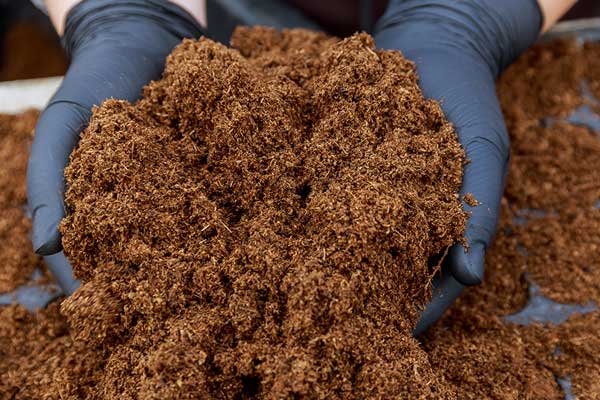
Related content:
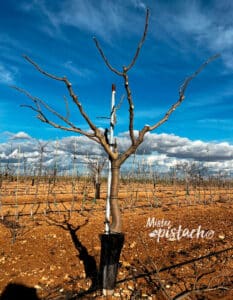
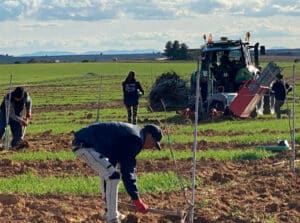
Pistachios: preparation of the land and planting the tree

Discover the farming techniques for growing pistachios

Application of copper in the pistachio tree: benefits and uses
Seeker:
Find out now:
You may also like:
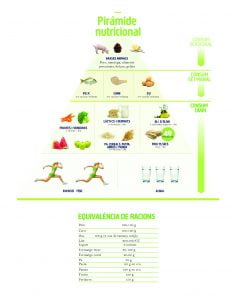
Pistachios star in the new pyramid of the Mediterranean Diet, one of the healthiest in the world.
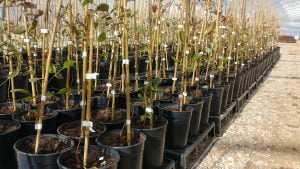

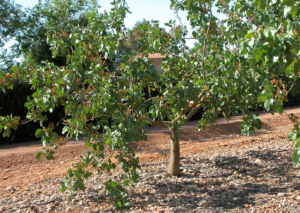
Pruning the pistachio tree: a key aspect in the cultivation and growth of the plant.
Entries by category:
Share this post with one click:
